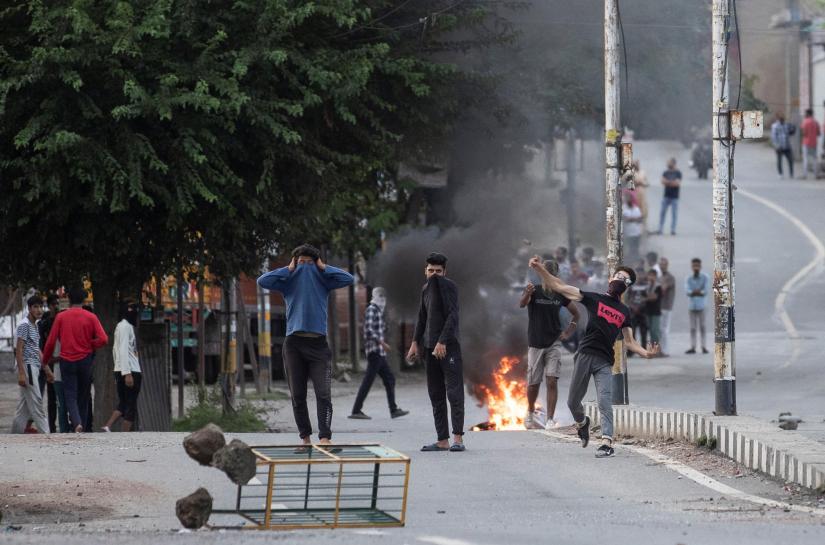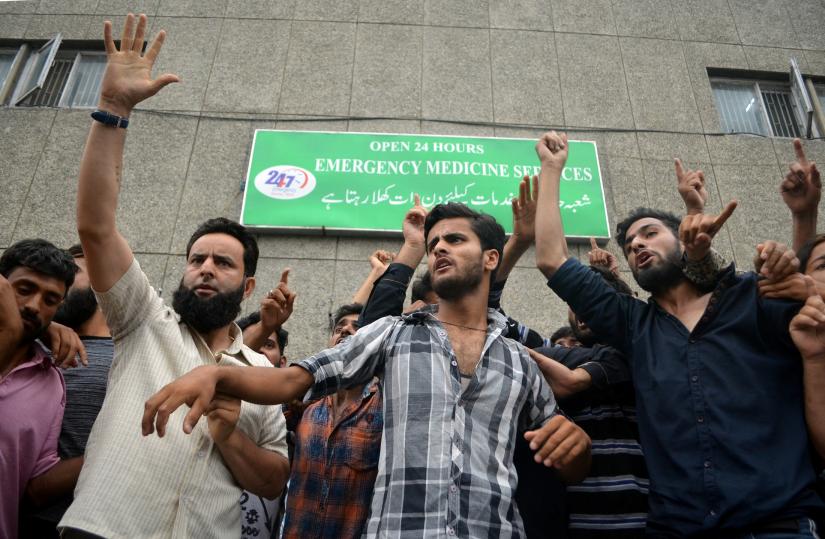 Widespread scepticism prevails in India about the new agenda of economic development for Jammu and Kashmir(J and K) the NDA II Ministry has now unfurled, following the abrogation on Aug 5 of Article 370. There has been some persistent questioning about New Delhi’s new, glorious visions of an economically prosperous Kashmir, even in the backdrop of overwhelming public support for the termination of ‘special state’ status enjoyed by J and K.
Widespread scepticism prevails in India about the new agenda of economic development for Jammu and Kashmir(J and K) the NDA II Ministry has now unfurled, following the abrogation on Aug 5 of Article 370. There has been some persistent questioning about New Delhi’s new, glorious visions of an economically prosperous Kashmir, even in the backdrop of overwhelming public support for the termination of ‘special state’ status enjoyed by J and K.
The Indian Government has launched a virtual propaganda blitz, intended to impress the people of J and K and the world at large, in equal measure. Large investments and major projects have been promised as major steps in the transition of Kashmir from a violence-torn area to a flourishing economic powerhouse.
On behalf of the Indian Railways, there is a move to upgrade the railway linkage between the J and K and the mainland. The government is prioritising the linking of the newly built Katra station with Banihal in Jammu, a distance of 111 kilometres, by 2020. From Banihal, a long road tunnel provides a connection with the Kashmir valley. It was built between 1952-1956.
The Katra-Banihal connection will complete the 356 kilometres long Jammu-Srinagar-Baramula linkage, undertaken at a cost of $60 billion a few years ago. Work on the other segments has been finished. From Baramula services could be extended to other parts of the Kashmir valley. The reason for the relatively slow pace of work on the Katra-Banihal section is the unusually difficult nature of the terrain.
Tunnels account for almost 100 kilometres of the project, in addition to the construction of 27 large and 10 smaller bridges. The highest bridge would be built at a height exceeding that of the Eiffel tower by 35 feet. However, opposition leaders argue that such a project was not undertaken with the sole objective of bringing the Kashmir closer to the mainland alone. Questions of strategic security and logistics keeping in view China’s massive infrastructure put up in Tibet and nearby by regions, also forced India’s hand.
Such initiatives would not be restricted to the public sector alone. The Kashmiris would also enjoy more than better connectivity with India. Mukesh Ambani’s Reliance group is about to send a task force soon to the J and K to identify areas where there could be speedy investments and the generation of new jobs. Ambani responded specially to the appeal to industrialists made by Indian Prime Minister Narendra Modi, to take a special interest in Kashmir.
Here, opposition leaders admit, the NDA’s initiative may touch a responsive chord among common peace-loving Kashmiris. Whether Muslims or Hindus, educated Kashmiri youths in recent years have been making their presence felt working in the IT, Engineering and other sectors in Bangalore, Hyderabad and other cities. There were few opportunities for them in the valley owing the prolonged insurgency and repeated outbreaks of violence. ‘A judicious blend of public and private sector investments in the troubled valley could certainly lead to closer economic integration with India. Look at Mizoram, Assam or Nagaland. Even a few years ago, some organisations in the Northeast were calling for secession. All that has ended after the Centre invested heavily in infrastructure building in the region, ensuring jobs and development for the locals,’ says Kolkata-based economist Shounak Mukherjee.
While Ambani’s offer was generally positive, Rajinder Gupta who heads the Trident group, was more specific. He proposed an immediate investment of at least Rs 10 billion, to launch projects that would empower women, especially by encouraging skill development. One report said he targeted employing at least 10,000 people at the first stage. Union Home Minister Amit Shah assured entrepreneurs that existing restrictions and regulations could be further eased, now that Kashmir was part of India, to enable greater investments and travel among people What helps the NDA II Ministry in carrying its message of new hope to the J and K is the crippling economic stagnation that has prevailed in the areas despite its rich earnings from tourism. Bakeries in and around Srinagar town according to media reports, have lost over Rs 2.7 billion in 2019 so far, because of repeated eruptions of violence. ‘Our products cannot be preserved indefinitely,’ shop owners complained. Kashmir Chamber of Commerce sources estimated that during the last two months, the valley alone lost nearly Rs 2 billion daily in terms of orders and booking cancelled, etc. ‘The plight of shikara owners, taxi drivers, guides, carpet makers, artisans specialising in making brassware etc, can be imagined. The same with restaurant owners and dry fruit sellers,’ rued a KCCI spokesman, according to sources.
What helps the NDA II Ministry in carrying its message of new hope to the J and K is the crippling economic stagnation that has prevailed in the areas despite its rich earnings from tourism. Bakeries in and around Srinagar town according to media reports, have lost over Rs 2.7 billion in 2019 so far, because of repeated eruptions of violence. ‘Our products cannot be preserved indefinitely,’ shop owners complained. Kashmir Chamber of Commerce sources estimated that during the last two months, the valley alone lost nearly Rs 2 billion daily in terms of orders and booking cancelled, etc. ‘The plight of shikara owners, taxi drivers, guides, carpet makers, artisans specialising in making brassware etc, can be imagined. The same with restaurant owners and dry fruit sellers,’ rued a KCCI spokesman, according to sources.
Not everyone is hopeful about the future. The biggest impediment to Kashmir’s progress could be the attitude of Pakistan. No one expects the ISI operatives and the numerous extremist Islamist terror groups they nurture will simply roll over and stop their attacks targeting the new administration in Kashmir. In the short and medium terms, there might well be an uptick in the level of their usual activities, of only to prove a point against the ‘Indian takeover!’ In such a scenario, the possibility of major new investments heading Kashmir’s way would be remote. There could be only a notional, token improvement in the local economy.
If this is beyond India’s control, it needs to be added that its own economy is not exactly looking rosy either. In the public sector, where is the money to invest ask economists. Last fiscal in 2018-19, the central government reported a massive 30% drop in its expenditure indicating a major slowdown. During the last six years, an estimated 9,100,000 people have reportedly lost their jobs in the organised and unorganised sectors. In the last three months, over 200,000 workers in the automobile sector have been laid off. Prime Minister Modi is holding serious talks with Finance Minister Nirmala Sitharaman about the prolonged economic stagnation. There have been no signs of any improvement in the economy yet. There no reason either to think that Kashmiris are not aware of these trends.
 International
International
41343 hour(s) 22 minute(s) ago ;
Morning 10:17 ; Saturday ; Jul 05, 2025
India: Kashmiris in for a bumpy ride?
Send
Ashis Biswas, Kolkata
Published : 07:30, Aug 19, 2019 | Updated : 07:30, Aug 19, 2019
Published : 07:30, Aug 19, 2019 | Updated : 07:30, Aug 19, 2019
0 ...0 ...
/hb/
Topics: Top StoriesExclusive
- KOICA donates medical supplies to BSMMU
- 5 more flights to take back British nationals to London
- Covid19: Rajarbagh, Mohammadpur worst affected
- Momen joins UN solidarity song over COVID-19 combat
- Covid-19: OIC to hold special meeting
- WFP begins food distribution in Cox’s Bazar
- WFP begins food distribution in Cox’s Bazar
- 290 return home to Australia
- Third charter flight for US citizens to return home
- Dhaka proposes to postpone D8 Summit
Unauthorized use of news, image, information, etc published by Bangla Tribune is punishable by copyright law. Appropriate legal steps will be taken by the management against any person or body that infringes those laws.
Bangla Tribune is one of the most revered online newspapers in Bangladesh, due to its reputation of neutral coverage and incisive analysis.
F R Tower, 8/C Panthapath, Shukrabad, Dhaka-1207 | Phone: 58151324; 58151326, Fax: 58151329 | Mob: 01730794527, 01730794528


